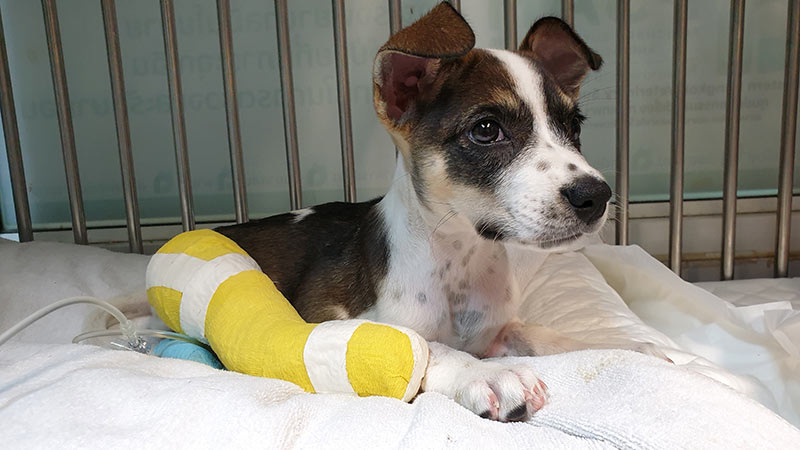Skeletal abnormality in dogs and cats
What is skeletal abnormality?
The skeleton is the internal bony framework of the body that is present in all vertebrate animals (those that have a backbone or spine). The skeletal system is composed of the hard tissues of the body: the bones, cartilage and other rigid material. Its primary functions are to provide structural support to the body and to protect the internal organs.
The skeletal bones of dogs and cats can be grouped in sub divisions:
- Appendicular skeleton – the bones of the limbs (legs and feet) and pelvis
- Axial skeleton – the bones of the head, neck, vertebrae (spine), ribs and sternum (breast bone)
- Visceral skeleton – small bones that form part of an organ (for e.g. the middle ear’s “ossicles”, penis’s “baculum”, and throat’s “hyoid”)
Bones are complex, living organisms with their own supply of blood vessels and nerves. They are composed of hard, mineralized tissue that may be classified according to their shape:
- Long bones – found in the limbs; support weight and allow large movement
- Short bones – found in the wrists (carpus, metacarpus) and ankles (tarsus, metatarsus); provide stability and fine movement
- Sesamoid bones – found near freely moving joints, such as the wrist and the knee (stifle)
- Flat bones – found in the sternum, shoulders, ribs and pelvis; provide for the attachment of muscles and long bones, and in the skull where they surround and protect the eyes, ears, sinuses, and brain
- Irregular bones – found in the vertebral column, the skull (those that are not of the flat type), and parts of the hip bone
The main functions of the bones are to:
- Provide the rigid structural framework of the body
- Protect the internal organs from damage
- Serve as levers that enable physical movement along with the muscles, tendons and ligaments
- Store calcium and phosphorus – these minerals are continuously deposited and withdrawn from the bone to support essential bodily function
- Produce blood cells – bone marrow serves as a factory for red blood cells and for several kinds of white blood cells
The dog’s skeleton
The dog skeleton has around 319 bones (dogs with longer tails have a couple more). It is formed to enable rapid movements such as running, hunting and chasing. For example, the dogs have a rudimentary collarbone made of cartilage and shoulder blades that are not tightly connected to its skeleton, allowing for greater stride length, faster motion and increased flexibility.

Dogs have the greatest variation in the size and configuration of their skeletons of any species of animal. Even though all breeds have the same number and type of bones, the size and shape of the bones can differ greatly between breeds. The biggest differences between breeds, other than sheer size, are in the bones of the skull.
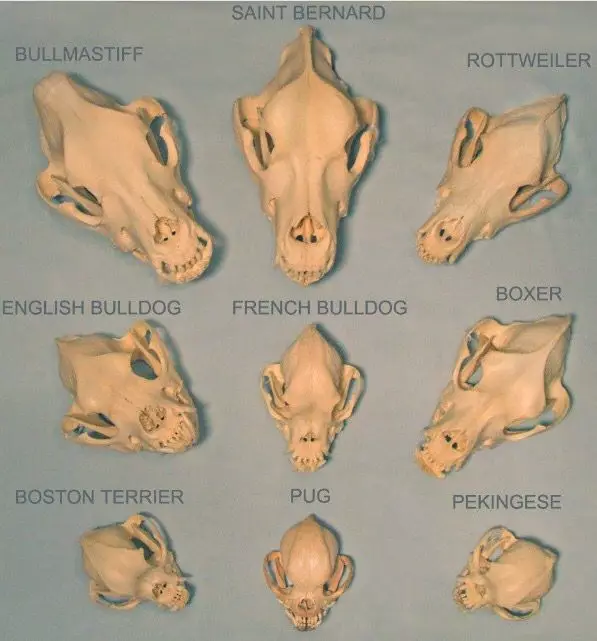
Source: https://i.pinimg.com/originals/28/92/6d/28926d9e64249372260208f85e893512.jpg
The cat’s skeleton
The average cat skeleton consists of between 240 to 245 bones, with variations in the number of tail bones and/or additional toes. The cat’s vertebrae are not as tightly connected as those of the human spine, allowing greater elasticity in the disks between the bones and making it much more flexible. Additionally, because of the position of the clavicle within the cat’s chest muscle, the cat’s chest is much narrower and deeper than that of other mammals, which enables a longer stride length and the ability to squeeze into narrow spaces.
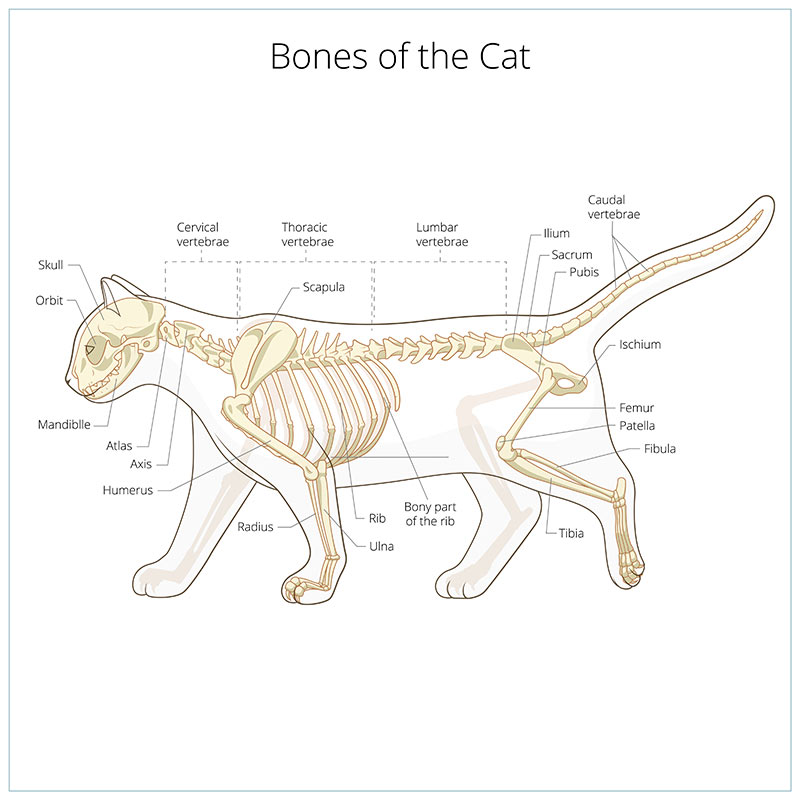
Skeletal abnormalities
Dogs and cats are prone to several disorders that affect the skeletal system, often resulting in lameness or bone deformities. Many of these disorders are congenital and/or developmental abnormalities, where the bone does not develop correctly in utero or the early years. Other skeletal abnormalities are degenerative disorders that are caused over time through wear and tear and stress on the bones and cartilage.
Examples of skeletal abnormalities that can occur in dogs and cats include the following (note that “osteo” refers to bone and “chrondo” to cartilage):
Bone fractures
Trauma to bones is probably the most common skeletal disorder occurring in dogs and cats. Broken bones (“fractures”) are often caused by car accidents or falls from a height. There are several types of fractures that can occur, including single or multiple and open (also called compound) or closed. Dogs and cats commonly suffer from fractures to the jaw, pelvis, skull and bones of the fore– and hind-limbs.
Hip dysplasia
A malformation of the hip joint causes the ball and socket to be misaligned and looser than normal, leading to a gradual deterioration and loss of function of the joint. Hip dysplasia occurs primarily in large breed dogs and is relatively rare in cats, although approximately 18% of Maine coon cats are reported to suffer from it (source).
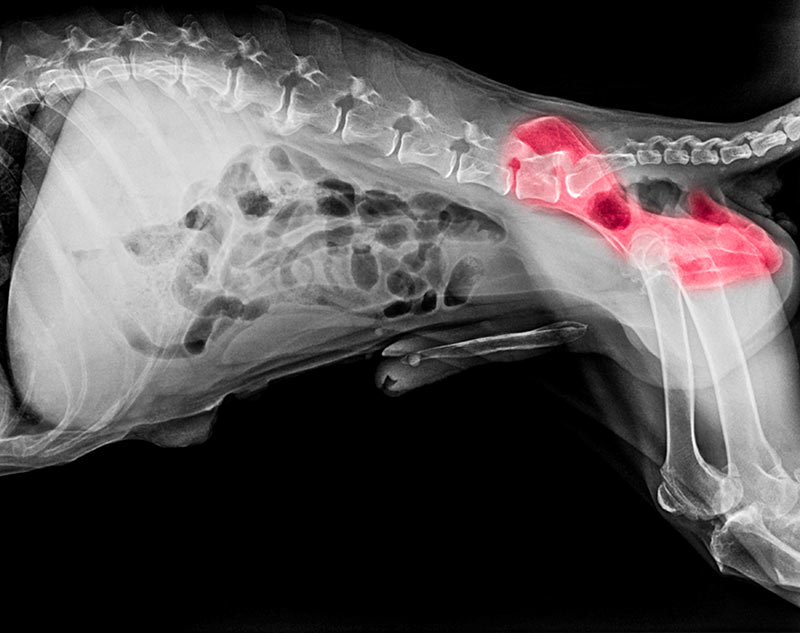
Osteochondrosis dissecans (OCD)
A developmental defect in the smooth cartilage lining the surfaces of the bones within one or more joints, especially in the shoulder, elbow, hock and knee (stifle). The cartilage becomes thick and prone to injury; when subjected to a force, it can crack and lift and lift away from the bone. Although OCD has been seen in cats and small dogs, it occurs primarily in young, growing, dogs of large and giant breed and less than one year of age.
Hypertrophic osteodystrophy (HOD)
A non-infectious inflammation occurring in the growth plates of the long bones of the front limbs during development; the bones that grow most rapidly are most severely affected. Swelling around the bone and the formation of bony deposits cause a widening of the bone, which can lead to tiny fractures and separation of the bone, as well as painful ossification (formation of new bone tissue). It is rare in cats and primarily affects young, growing, large- and giant breeds of dogs.
Osteochondromatosis / Multiple cartilaginous exostoses (MCE)
The presence of abnormal bone proliferations or enlargements (“osteochondromas”) on the growth plates, particularly those of the long bones, ribs, and vertebrae. An uncommon disorder in young animals that usually ceases at skeletal maturity. In older cats, it is believed to be caused by infection with the feline leukaemia virus.
Osteochondrodysplasia and achondroplasia
A rare group of developmental disorders of the skeletal system which causes abnormal bone growth and bone deformities in the size and shape of the limb, spine and/or skull bones. It occurs in several breeds of dogs, often resulting in disproportionate dwarfism. In most cases the cause is genetic – in cats, the Scottish fold breed has been found to be predisposed to osteochondrodysplasia of the limb bones (metacarpus, metatarsus and phalanges), which are short and deformed. In dogs, a similar condition occurs in Scottish deerhounds and bull terriers.
Achondroplasia is the most common form of osteochondrodysplasia; the bones do not grow to the normal size, based on what is expected of the breed. This is caused by a genetic mutation. The result is abnormally short limbs, a condition called dwarfism. In some breeds this trait is selectively encouraged, such as with the Munchkin breed.
Osteogenesis imperfecta
Also known as “brittle bone disease”, animals with osteogenesis imperfecta inherit very fragile bones, resulting in bones that break easily. The long bones tend to be slender with thin outer layers. This severe skeletal disorder has no cure and is most common in Beagles, Standard Wirehaired Dachshunds, Golden Retrievers, Poodles, Bedlington Terriers, Norwegian Elkhounds, and the Standard and Miniature Smooth haired Dachshund.
Osteomyelitis
An inflammation of the bone or bone marrow usually caused by a bacterial infection and more rarely, by a fungal infection. It can occur following a traumatic injury (where there is bone damage and/or an open wound), or post-operatively. Infection can begin elsewhere in the body and spread to the bone or bone marrow through the bloodstream.
Panosteitis
Also known as “growing pains”, a spontaneously occurring inflammation in the marrow cavity of the long bones, making it challenging and painful to move around. It can occur in any breed, but more commonly affects primarily young, large- or giant dogs breed and young medium- to large-sized cat breeds.
Osteosarcoma
The most common primary bone tumour, accounting for over 95% of all bone tumours (source). In dogs, it is a highly destructive and debilitating bone disease, particularly when it occurs in the appendicular skeleton (the limbs). Osteosarcoma is also the most common feline bone tumour but is typically less aggressive in cats than in dogs.
In dogs, large or giant, and particularly tall, animals are at a greater risk for the development of osteosarcoma compared with the general dog population, although small dogs (less than 15 kg) can also be affected. While osteosarcoma can occur in dogs of all ages, older dogs are most commonly affected.
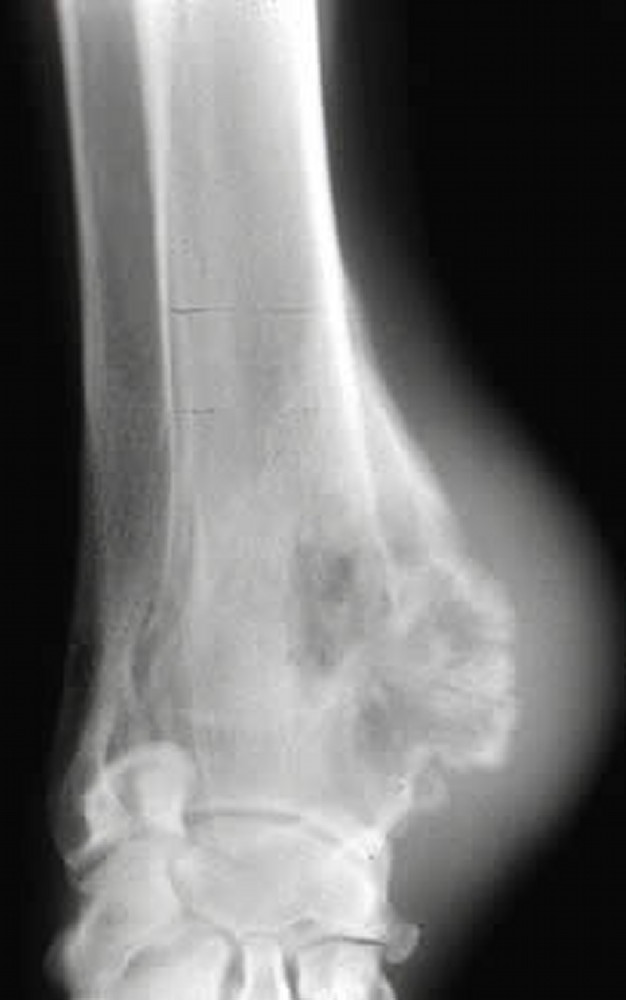
Source: https://www.merckvetmanual.com/musculoskeletal-system/osteopathies-in-small-animals/bone-tumors-in-small-animals
Several other rare congenital and inherited musculoskeletal disorders have been seen in dogs and cats, including:
- Apodia – congenital absence of feet
- Hemimelia – congenital absence of bones in the limbs, most commonly the radius
- Ectrodactyly – (split-hand or lobster claw) born with split or absent digits
- Syndactyly – two or more digits that are fused together
- Polydactyly – the presence of extra toes
Symptoms of skeletal abnormality in dogs and cats
While lameness is often the primary sign that may indicate a skeletal abnormality, symptoms can vary depending on the condition, for example:
- Hip dysplasia – lameness, limping, pain, difficulty moving from lying to standing, a bunny-hopping gait in the rear legs, a reluctance to walk, and stiffness in the rear legs; in mild cases there may be no visible symptoms
- Osteochondrosis dissecans (OCD) – pain (varying from mild and intermittent to severe and constant), limping in one or both hind limbs, trouble upon rising or appearing stiff when walking; a characteristic “slinky” gait has been described for some hind limb OCD animal
- Hypertrophic osteodystrophy (HOD) – swelling and pain of the bone just above the joints, pain in the joints, fever and loss of appetite
- Multiple cartilaginous exostoses (MCE) – lameness and discomfort
- Osteogenesis Imperfecta – pain, loose joints, difficulty walking, spontaneous fractures, reduced bone mass, stunted growth, muscle atrophy
- Osteochondrodysplasia and Achondroplasia – poor growth, abnormal bone shape, larger head than normal, shorter jaw and nose, crooked teeth, bowed forelimbs, skew spine, enlarged joints
- Osteomyelitis (inflammation of bone) – lameness and pain, red, swollen and/or pus-filled sores (ulcers) at the wound site, fever, lethargy, persistent decreased appetite and depression
- Osteochondromatosis (Multiple Exostoses) – there may be no signs, or lameness or pain may develop
- Panosteitis (inflammation in the marrow cavity of the long bones) – difficulty in moving, pain in the bone or limb, lameness, fever, loss of appetite and lethargy
- Bone tumour / cancer – symptoms depend on the site of the tumour, including lameness where the tumour is in a limb, bone swelling, and fractures of the bone that are not caused by injury
Causes of skeletal abnormality in dogs and cats
The causes of skeletal abnormalities can be hereditary (or breed-related / genetic). developmental, nutritional, infectious, traumatic, neoplastic (cancer) secondary to other diseases or of unknown origin. Some skeletal abnormalities in dogs and cats are thought to be caused by a combination of these factors. Osteochondrosis (OCD), for example, has a causal pathway that includes genetics, rapid growth, excessive dietary calcium, and trauma.
Hereditary abnormalities
A hereditary or genetic condition is one that is passed down from one or both parents and/or is more prevalent in a particular breed. Osteogenesis imperfecta (brittle bones) and polydactyly (having extra toes) are examples of hereditary disorders. Some hereditary diseases are present at birth while others become manifest during growth or later in life (i.e., acquired hereditary diseases). For example, in most cases of osteochondrodysplasia, the cause is genetic, and diagnosis can be made at birth, or even prenatally, by ultrasound (source).
Often more than one gene is involved in hereditary skeletal abnormalities, and in many of these conditions environmental factors also play a role. For instance, hip dysplasia is a common hereditary disorder with multiple genes involved, occurring in many large breeds of dogs such as golden retrievers, Labradors, mastiffs and German shepherds; however, the development and progression of hip dysplasia is also dependent on environmental conditions such as obesity, rapid weight gain and poor nutrition.
One way to prevent hereditary abnormalities is through genetic management. In other words, affected animals are spayed or neutered so as not to pass on the genetic traits that may lead to this condition.
Developmental abnormalities
A developmental condition is one that occurs during the animal’s development, either in utero or later in life. Developmental bone disorders appear in young animals when the bones do not grow correctly. They may be congenital (present at birth) or occur as the animal grows.
Nutritional deficiencies in the mother’s diet during pregnancy can cause malformations in the skeletal system of the growing foetus. Hereditary breed characteristics can also cause developmental abnormalities, for example, bulldogs, pugs, Boston terriers, basset hounds and dachshunds are susceptible to abnormal development of the bones of the foreleg (radius and ulna), resulting in lameness.
Nutritional deficiencies
When animals are not fed the right diet for their breed and/ or weight and/or age, nutrition-related bone conditions can occur. For example, nutrition is suspected to play a role in osteochondrosis and hypertrophic osteodystrophy (source). Reduced bone mass, bone deformities, bony growths, fractures, lameness and loose teeth are all conditions that can result from nutritional deficiencies (source).
Mineral imbalances in the diet, particularly of trace minerals such as copper, zinc, and magnesium, are a common dietary cause of bone defects. An excess or deficiency of vitamins, particularly vitamins A and D, can also influence bone growth and development. A deficiency in vitamin D in the diet, or low conversion of vitamin D in the body from a lack of exposure to sunlight, can affect the development of bone.
An excess of protein in the diet can cause an imbalance of calcium and phosphorus in the body, which can develop into nutritional disorders affecting the bones. A calcium deficiency or imbalance in the diet can cause rickets, a severe weakening of the bone that arises most often in young dogs fed an all meat diet. In puppies it causes lameness, deformities and fractures of the bone.
Trauma
Trauma to bones is regarded as the most common cause of skeletal disorders in dogs and cats, especially in animals allowed to roam free. Trauma includes falls from a great height, automobile accidents, fights and even gunshot wounds.
Infections
The most common cause of inflammation of the bone or bone marrow is bacterial infection, as in the case of osteomyelitis. Bacterial contamination of a wound such as a fracture, bite wound or laceration near a bone can spread to the bone. Infections that cause bone tissue to break down and die can lead to bone disorders.
Systemic infections (infections occurring in other areas of the body) can also reach the bone or marrow through the bloodstream; for example, when osteochondromatosis occurs in older cats, it is believed to be caused by infection with the feline leukaemia virus. Less common causes of bone infections are fungal infection or the presence of surgical implants, such as a prosthetic joint or bone plates and pins.
Secondary to other diseases
Some disorders that cause abnormalities in the circulating levels of calcium, phosphorous and certain vitamins can adversely affect bones. Chronic kidney failure affects bone by altering the amount of phosphorus and vitamin D in the body. The bones become soft, thin, and weak.
Metabolic diseases result from too much or too little of a particular hormone or other substance in the body. Panosteitis, osteochondrosis, and hypertrophic osteodystrophy are the three most common metabolic bone disorders seen in dogs. In other situations, diseases of the ligaments or tendons may cause secondary bone abnormalities.
Cancer
Skeletal tumours can arise within the tissues of the bone (primary cancer), or can invade bones from the surrounding soft tissues, or spread to the bone from a primary location in another part of the body (metastasis). The most common primary bone tumour is osteosarcoma of the radius, humerus, femur, or tibia.
Rarely, tumours can occur at sites of previous bone damage, including fractures, orthopaedic implants (used for fracture repair or joint replacement), radiation therapy, and bone diseases. Most primary bone tumours, particularly osteosarcoma, develop spontaneously with no apparent predisposing cause. There appears to be a genetic predisposition to developing osteosarcoma in Scottish Deerhounds and this tumour also occurs frequently in other large breed dogs, particularly the Rottweiler. Large or giant, and particularly tall, dogs are at a greater risk for the development of osteosarcoma compared to the general dog population.
Unknown origin
The exact causes of some skeletal abnormalities are unknown, although a combination of the above factors may play a role. For example, some factors thought to play a role in the origin of panosteitis include genetics (in German Shepherds), stress, infection, or the body’s own metabolic and immune responses (source).
How is skeletal abnormality in dogs and cats diagnosed?
If an animal is persistently limping, the veterinarian may suspect a skeletal abnormality. Diagnostic techniques used to determine a skeletal abnormality will depend on other symptoms observed and will include one or more of the following:
History
A thorough history of the animal’s health, onset of symptoms, and any possible incidents or injuries that may have contributed to the symptoms will need to be provided. Any information regarding parentage (family history) will be helpful, particularly where there may be a genetic basis to the condition.
Physical and orthopaedic examination
The initial evaluation of the skeleton involves a thorough examination to assess general health and identify any other problems. The animal may be observed in the examination room for signs of lameness and abnormalities in gait. Orthopaedic examination and palpation of the affected bones and/or joints is necessary to identify possible causes of lameness, for example, hip dysplasia.
Radiography
X-rays are a crucial tool in evaluating the skeleton. Bone and some forms of cartilage show up very well on x-rays. Some x-rays may be taken with the animal awake and sedated, while others may require that the animal be completely anesthetised.
Routine laboratory tests
A complete blood count, biochemistry profile and urinalysis are performed to assess general health and look for signs of underlying infection and/or abnormalities in circulating levels of calcium, phosphorus and vitamin D. These tests are also helpful to detect other underlying disorders that may affect the bones, such as kidney disease, anaemia and leukaemia.
Special laboratory tests
If an infection of the bone is suspected, samples of fluid or pus may be collected for analysis and bacterial or fungal cultures. Occasionally the levels of vitamin D and parathyroid hormones are measured in the blood.
Genetic tests
If the condition is identified as genetic (inherited), a buccal (cheek) swab will be taken for laboratory analysis to determine if the animal is a carrier of the gene.
Bone biopsy
Identification of the type of bone disease present may require a bone biopsy, where a core sample of the suspected tumour is obtained for analysis by a pathologist. This is especially recommended where the presentation is atypical, in cases of congenital and developmental bone diseases, osteomyelitis and bone tumours. In cases of tumours, a biopsy of the suspected tumour itself is taken; because different types of tumours respond differently to various treatments, a biopsy can help to determine the best treatment plan.
Bone marrow biopsy
Biopsy of the bone marrow cavity is done via passage of a needle into the red bone marrow of one or more bones and aspiration of a sample of the bone marrow. The bone marrow sample is then sent to a veterinary pathologist for microscopic examination.
Advanced imaging techniques
CT (computed tomography) scans and MRI (magnetic resonance imaging) are very useful in examining bones and their adjacent soft tissues, such as cartilage, ligaments, and tendons. CT scans are recommended for many tumours of the axial skeleton as the cross-sectional and three-dimensional images provide better information than traditional radiography.
A whole-body bone scan is the most effective technique to evaluate for the presence of metastatic disease in another bone, although nuclear medicine facilities may not be widely available. Radioisotope bone scans, where a radioactive marker is put in the bloodstream that can highlight bone tumours with a special imaging technology, are also helpful if available.
Chest x-rays
Chest x-rays may be taken to look for evidence of infection or tumours that have spread to the lungs, and to identify abnormalities in the ribs or vertebrae of the chest.
Surgery
Surgical biopsy of the bone may be conducted for further analysis. Arthroscopy, where a small camera attached to a flexible tube is inserted into the joint through a small incision, or arthrotomy (an open-joint procedure) may be performed for a more accurate diagnosis.
Prognosis
The prognosis for many skeletal abnormalities depends on the specific condition, the severity of the problem and the availability of treatment options. Bone deformities can cause significant pain and difficulty for some animals, while others learn to compensate and continue to live comfortably.
If detected early, some of the skeletal disorders can be corrected, and a full return to healthy life is possible. Many others can be successfully managed with early diagnosis and appropriate care. However, in some skeletal conditions, such as osteosarcomas, the outlook for recovery is guarded, with untreated animals rarely living more than several months. A cure for dogs with appendicular osteosarcoma is achieved in less than 25% of cases.
Treatment for skeletal abnormality in dogs and cats
Treatment for skeletal abnormalities depends on the specific condition, the severity of the problem and the availability of treatment options. Some conditions will require hospitalisation for supportive care or surgery.
Surgery
Surgical procedures vary depending on the presenting skeletal abnormality:
- Tumours – surgery, whether limb amputation or limb-sparing, is the foremost treatment; limb amputation is considered the gold standard for the surgical treatment of primary bone tumours, and the complication rate is very low
- Fractures – surgery to stabilise a bone fracture includes the use of implants or other fixation material, such as plates, screws, wires and pins, depending on the location and severity of the fracture
- Osteochondrosis dissecans (OCD) – optimal treatment typically involves surgery to remove abnormal cartilage, performed by arthroscopy, where a small camera attached to a flexible tube, or endoscope, is inserted into the joint through a small incision, or arthrotomy, an open-joint procedure
- Hip dysplasia – there are four main surgeries that may be recommended, depending on the animal’s size and age: triple pelvic osteotomy (TPO), juvenile pubic symphysiodesis (JPS), total hip replacement (THR) and excision arthroplasty (EA)
- Amputation – if there is too much damaged bone or tissue damage, amputation of a digit, tail, or limb may be the recommended treatment option, or the only effective strategy for saving the animal’s life
Conservative management
Conservative treatment options include medications, exercise restriction (until the signs completely subside), and appropriate weight and nutritional management.
Medication
Relieving pain is an important component of treatment for lame animals and may allow faster recovery. Pain medication can also help animals with chronic conditions, such as osteoarthritis. The veterinarian may prescribe appropriate nonsteroidal anti-inflammatory drugs (NSAIDS) to reduce swelling and inflammation, and/or pain-relieving medications to reduce the severity of the pain caused by bone abnormalities. Steroids can also be effective in the reduction of inflammation in the bones.
If there is a bacterial infection, antibiotics will be prescribed, possibly long-term. Antifungal drugs will be given for fungal infections. Nutraceuticals (such as glucosamine) may be recommended for conditions affecting the cartilage and/or joints.
Weight control
Weight control is an important aspect of recovery and ongoing management in order to decrease the pressure applied to the affected limb or joint. The risk of weight gain needs to be kept in mind where physical mobility is reduced, whether there is a reduction of exercise during recovery or as a long-term consequence of the condition.
Nutrition
Ensuring that a dog or cat has the proper nutrition required for strong bones is critical for optimal health. Good nutrition is particularly important during the growing years, especially for animals of susceptible breeds, to decrease the likelihood of some skeletal abnormalities. Reduced bone mass, bone deformities, bony growths, fractures, and loose teeth are all conditions that can result from nutritional deficiencies.
- Getting either too much or too little of certain vitamins, particularly deficiency of vitamin D or an excessive intake of vitamin A, can influence bone growth and development; treatment is targeted as addressing the imbalance.
- A calcium deficiency in animals that are fed an all-meat diet, which is high in phosphates and low in calcium, is treated with calcium supplementation and a balanced diet.
- An imbalanced level of minerals in the diet, particularly of trace minerals such as copper, zinc, and magnesium, is a common dietary cause of bone defects.
- Growing animals that are fed too much protein or have improper balance of calcium and phosphorus can also develop nutritional disorders affecting bones.
No treatment
Some skeletal abnormalities have no known cure, including hypertrophic osteodystrophy, osteochondrodysplasia and osteogenesis imperfecta. Some animals learn to compensate for their disability and manage to live relatively normal lives. However, in severe cases, animals may have to be euthanised.
Other treatment options may include
- Physiotherapy, acupuncture or massage (passive joint motion) to decrease joint stiffness and help maintain muscle integrity
- Chemotherapy, usually following surgery, particularly in cases of osteosarcomas
- Hospitalisation with bed rest and frequent turning
- Intravenous fluid therapy, if the animal is dehydrated
- Irrigation, flushing, cleaning and draining of any open wound
- Removal of dead, damaged, or infected tissue
- Removal of loose implants
- Bone grafting
- Stem cell therapy
- Palliative treatment, in cases of malignant tumours, to provide pain control and improve comfort for the remaining lifespan
In summary
Dogs and cats can suffer from disorders that affect the skeletal system, resulting in lameness or bone deformities. Skeletal abnormalities can be developmental, genetic, infectious, nutritional, traumatic, or neoplastic in origin. In many cases there is an interplay of inherited breed characteristics with environmental and other factors. The degree of impairment depends on the specific problem and its severity, but limping and pain are symptoms common to many of them.
X-rays are a crucial tool in diagnosing skeletal abnormalities. Treatment options range from medication to relieve pain and inflammation, to surgery, to no treatment. Supportive care and dietary changes may be recommended. Prognosis is varied, with some skeletal abnormalities having a much more optimistic outlook than others.
Bow Wow Meow Pet Insurance can help protect you and your pet should an unexpected trip to your vet occur.
- Find out more about our dog insurance options
- Find out more about our cat insurance options
- Get an instant online pet insurance quote
Bow Wow Meow is proud to have been awarded winner of Canstar’s ‘Most Satisfied Customers’ Award in the Pet Insurance category for both 2024 and 2025!
Bow Wow Meow is proud to have been chosen as Product Review’s Pet Insurance Award Winner every year from 2018 to 2025! This is based on 2,995 independent customer reviews (as at 21/01/2025), with an overall rating of 4.3*
Google Review rating = 4.5* (based on 968 reviews)
Trust Pilot rating = 4.6* (based on 531 reviews)
Bow Wow Meow is proud to have been chosen as Product Review’s Pet Insurance Award Winner every year from 2018 to 2025! This is based on 2,995 independent customer reviews (as at 21/01/2025), with an overall rating of 4.3*
Google Review rating = 4.5* (based on 968 reviews)
Trust Pilot rating = 4.6* (based on 531 reviews)
Bow Wow Meow has been chosen as a winner in the Finder Pet Insurance Awards 2024. Finder’s panel of experts analysed over 140 quotes to award our Ultimate Care Plan the winner of the “Pet Insurance – Value” category.
More information
- https://www.petplace.com/article/dogs/pet-health/structure-and-function-of-the-skeleton-in-dogs/
- https://www.petmd.com/cat/conditions/musculoskeletal/c_ct_osteochondrodysplasia?page=show
- https://www.msdvetmanual.com/cat-owners/bone,-joint,-and-muscle-disorders-of-cats/congenital-and-inherited-disorders-of-bones,-joints,-and-muscles-in-cats
- http://boneo.bio-rep.com/health/dog-bone-and-joint-problems/bone-diseases-in-dogs
- http://boneo.bio-rep.com/health/dog-bone-and-joint-health/canine-skeletal-system
- https://www.vin.com/apputil/content/defaultadv1.aspx?meta=Generic&pId=11181&id=3852278
- http://www.pethealthnetwork.com/dog-health/dog-diseases-conditions-a-z/bone-diseases-growing-dogs-and-puppies
- http://www.pethealthnetwork.com/dog-health/dog-diseases-conditions-a-z/bone-diseases-growing-dogs-and-puppies
- https://www.msdvetmanual.com/dog-owners/bone,-joint,-and-muscle-disorders-of-dogs/bone-disorders-in-dogs
- https://www.petcoach.co/article/skeletal-anatomy-bones-joints-and-muscles-in-dogs/
- https://www.cat-world.com.au/bones-of-the-cat.html
- https://www.petmd.com/cat/conditions/musculoskeletal/c_ct_panosteitis
- https://www.petmd.com/cat/conditions/musculoskeletal/c_ct_hip_dysplasia
- http://www.vetstreet.com/care/osteochondrosis-osteochondritis-dissecans-ocd-of-the-knee-ankle-and-spine-in-dogs
- https://www.petmd.com/dog/conditions/musculoskeletal/c_dg_osteodystrophy
- https://www.petmd.com/cat/conditions/musculoskeletal/c_ct_osteomyelitis
- https://www.acvs.org/small-animal/bone-tumors
- https://wagwalking.com/condition/osteogenesis-imperfecta
- https://www.sciencedirect.com/topics/veterinary-science-and-veterinary-medicine/osteochondrodysplasia
- https://www.petmd.com/dog/general-health/bone-problems-can-affect-your-pet

